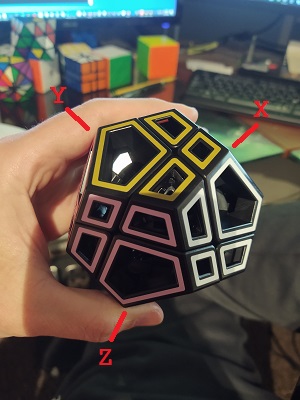

This Skewb has quickly become, in my mind, a classic twisty puzzle, deserving as much attention as the Rubik's Cube. It's just a good puzzle every cuber (or dodecahedroner) should have.
As far as solving goes, there's no difference between a regular skewb and a hollow skewb. The hollow one just looks cooler.
There are two perspectives used in the solve. They are as follows.


For the second of these, I'll let x denote an axis parallel to that used by X, but
in the opposite direction. Since any rotation of the puzzle rotates half the puzzle, this means that the net
effect of x is the same as X', and the same goes with x' versus X.
Using the notation given on the home-page, we would say that x=!X, but I'm using lower-case letters
here for convenience.
Also, I'm going to let W denote an axis pointing straight at you in both perspectives shown above.
Permute the large pieces into position. A single rotation of any face is an obvious tri-cycle of
3 large pieces in a triangular pattern. To tri-cycle 3 of them in a row (or column), use C',B,C.
Permute the small pieces into position. Clearly, W will tri-cycle 3 small pieces, but at the expense
of also doing that to 3 large pieces. To compensate, use W,4[x',z,x,z']. This performs the same tri-cycle
of the same small pieces, but preserves the position of the large pieces. Note that alot of flipping of orientation
occurs here, making it a bit tricky to see that it works. Performing this sequence on a solved skewb makes it easier
to see that it works.
Note that another small piece permutor is R=3[X,Y',X',Y], which does a pair of swaps, which is sometimes useful
on its own, but I mainly use it to re-orient small peices, as shown in Step 4.
Orient large pieces. The sequence 2[2Q,|W|] will perform a pair of large piece flips, where Q=B,C',B',C.
The pieces flipped are those on the top and bottom of the puzzle. Use setups, of course, to get what pair of peices you want flipped
to flip.
Orient small peices. Use R,z,R',z' to rotate a pair of small pieces one way, or R,z',R',z to
rotate them the other way.
The solve above is the classic steps in every twisty-puzzle solve: position all piece types, then orient all piece types. But in practice, this isn't really feasible on the skewb, because the mis-oriented peices make it very hard to tell if they're in the right position or not. Therefore, what I really do as a first step is try to get a single face of the dodecahedron solved, then maybe another, then go from there with the usual steps. Getting a single face (or two adjacent faces) solved can be done intuitively while most of the puzzle is scrambled anyway.
Small digression: I can't imagine orienting and then positioning, but I suppose that's conceivable. The problem with this order is that changing the position of a piece often changes its orientation as well. (In fact, orientation may be measured relative to a piece's position on the puzzle.) But changing orientation always preserves position.